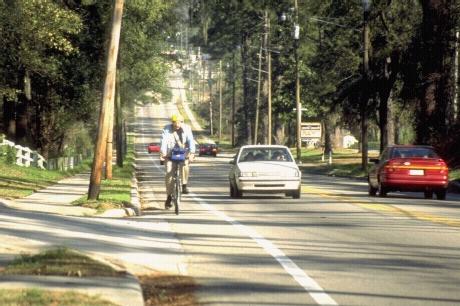U.S. Department of Transportation
Federal Highway Administration
1200 New Jersey Avenue, SE
Washington, DC 20590
202-366-4000
Federal Highway Administration Research and Technology
Coordinating, Developing, and Delivering Highway Transportation Innovations
 |
| This report is an archived publication and may contain dated technical, contact, and link information |
|
Publication Number: FHWA-RD-98-166
Date: July 1999 |
Guidebook on Methods to Estimate Non-Motorized Travel: Supporting Documentation2.3 Bicycle Sketch Plan Methods
Descriptive Criteria: What is It? Categories: Authors and Development Dates: Goldsmith (1997) Purpose: Sketch plan methods can be defined as a series of "back-of-the-envelope" calculations to estimate the number of bicyclists using a facility or area. These methods generally rely on data that already exist or can be collected with relative ease (such as census and land use data), combined with behavioral assumptions derived from other studies. Sketch plan methods tend to vary widely in their specific approaches and in their level of sophistication. Goldsmith (1997) developed and applied a sketch-plan method to estimate the impact of a new bicycle facility in the Seattle, WA, area on reducing motor vehicle VMT (vehicle miles of travel) and emissions. Structure: Goldsmith: 1. Determine the location and boundaries of the travel shed (i.e., the area from which most trips on the facility are expected to originate). 2. Determine the population of census tracts within the travel shed. 3. Use census or survey data to determine the percentage of daily commuters within the travel shed. 4. Use census or survey data to determine the bicycle mode split for each census tract within the travel shed. 5. Estimate the number of potential bicycle commuters using the rate of current bicycle commuting in the travel shed as a comparison. For example, if the travel shed has a higher bicycle mode split than the census, then the potential bicycle commuter rate also should be higher. Also could use the proportion of population under 45 years relative to the city average to estimate the potential riding population. Multiply the rate by the total number of commuters in the travel shed and then subtract the number of current bicycle commuters. 6. Determine the expected number of new bicycle trips by assuming that a certain percentage of the population will divert trips from other modes to bicycling. For example, the Seattle survey showed that 26 percent of the potential bicycle commuting population would become bicycle commuters. 7. Determine the proportion of these trips that came from single-occupancy vehicle (SOV) trips. For example, the Seattle survey showed that one in two would be diverted from SOV trips. 8. Determine trip lengths using the city-wide average or one calculated from central locations within the census tracts to main trip generators. 9. Calculate the estimated number of VMT eliminated and emissions prevented using emissions assumptions as shown below in the "Assumptions" entry. Calibration/Validation Approach: Goldsmith: The technique should be tested in other settings to ensure its transferability. Furthermore, before and after bicycle counts could help to better improve the accuracy of this type of estimation technique. Inputs/Data Needs: Goldsmith: The VMT/emissions model requires the following data items:
Potential Data Sources: Goldsmith: Not applicable. Computational Requirements: Goldsmith: Uses spreadsheets. User Skill/Knowledge: Goldsmith: Users should be familiar with the bicycle-related data that are available in the respective area. Assumptions: Goldsmith: The following assumptions were made for each information need:
Facility Design Factors: Goldsmith: This method does not consider the impact of facility design factors on bicycle travel demand. Output Types: Goldsmith: The output consists of new bicycle commute and non-work utilitarian trips per day, and their impact on reducing SOV trips, VMT, and emissions. The following table illustrates the estimated reductions in SOV trips and VMT.
Real-World Examples: Goldsmith: Proposed bicycle lanes on Pine Street in Seattle, Washington, were used as the case study for the method. Examples taken from this case study are shown above in the input, output and assumptions entries. The author would like to test this method on other proposed facilities to ensure its transferability. Contacts/Source: Stuart Goldsmith, City of Seattle, Engineering Department, Seattle, WA. Publications: Goldsmith, Stuart, Draft: Estimating the Effect of Bicycle Facilities on VMT and Emissions, Seattle Engineering Department, 1997.

Performance: Goldsmith: The author believes that the method provides reasonable estimates of the impact that a new facility would have based on limited data such as census and travel survey data. The performance of the model in other situations has not been tested; local conditions vary considerably and bicycle-related data may be scarce in most jurisdictions. Furthermore, a number of assumptions are made in estimating the travel shed, current number of bicycle trips, and percentage of people who would choose to bicycle as a result of the new facility. Use of Existing Resources: Goldsmith: The method uses readily available data such as the census and local household travel survey data. The method also can use local preference surveys regarding travel behavior, although such survey data do not always exist. Travel Demand Model Integration: Goldsmith: The method is not designed for integration with regional travel models. Applicability to Diverse Conditions: Goldsmith: The inputs vary depending on the locality. For example, the travel shed is determined on a case-by-case basis. Once the travel shed is selected, the demographics and bicycle trip information then can be assessed. Usage in Decision-Making: Goldsmith: The method could be used to determine the VMT and emission reductions that could occur from specific proposed bicycle-related projects. This information is needed for air quality-related funding sources such as the Congestion Mitigation and Air Quality (CMAQ) program. Ability to Incorporate Changes: Goldsmith: Changes to the inputs can be easily incorporated into the estimation technique. Ease-of-Use: Goldsmith: The technique uses transportation data such as census data, and other existing data from transportation surveys.
FHWA-RD-98-166 |